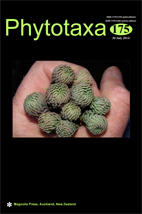Abstract
Three new species in the diatom genus Eunotia were found in the freshwater ponds and streams of Acadia National Park, Maine, USA. Eunotia novaeangliae sp. nov. belongs to the E. incisa group, species with nose-like apices and terminal raphe fissures distant from the ends. It is most similar to E. tenelloides in that species cluster, although differs in the valve shape, geographical distribution, several ultrastructural details and slight but consistent differences in valve dimensions and striae density. Eunotia panda sp. nov. is in the E. bilunaris group, species with slight even curvature and smooth margins of the valves. However, E. panda can be distinguished from E. bilunaris by dorsally slightly recurved apices with rounded ends, ultrastructural details and noticeably constant valve width. Eunotia spatulata sp. nov. is most similar to E. eurycephala, but differs from that taxon by having straighter and significantly larger valves with more swollen apices. All three taxa were sufficiently abundant in the samples collected from the park that they could be found in both SEM and LM microscopes. Eunotia novaeangliae and E. panda have both been illustrated in other publications before but not named. All three species occurred in waters of low conductivity and pH, typical for the genus. Acadia National Park appears to be a hotspot for Eunotia species diversity, and further study of the oligotrophic waters of this site is certainly warranted.

